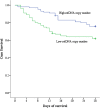Association between circulating mononuclear cell mitochondrial DNA copy number and in-hospital mortality in septic patients: A prospective observational study based on the Sepsis-3 definition
- PMID: 30794688
- PMCID: PMC6386339
- DOI: 10.1371/journal.pone.0212808
Association between circulating mononuclear cell mitochondrial DNA copy number and in-hospital mortality in septic patients: A prospective observational study based on the Sepsis-3 definition
Abstract
Purpose: To explore the association between circulating mononuclear cell mitochondrial DNA copy number and the prognosis of sepsis patients based on the Third International Consensus Definitions for Sepsis and Septic Shock (Sepsis-3 definition).
Methods: A total of 200 adult patients who had recently devoloped sepsis were prospectively recruited as the study cohort. Demographic and clinical data were recorded along with a 28-day outcome. Mononuclear cell mtDNA copy number was assessed by quantitative PCR.
Results: The 28-day outcome of sepsis patients was significantly associated with circulating mononuclear cell mtDNA copy number. The median mononuclear cell relative mtDNA copy number of survivors was significantly higher than that of nonsurvivors (406.68, range 196.65-625.35 vs. 320.57, range 175.98-437.33, p = 0.001). The Cox proportional hazard survival model analysis indicated that mononuclear cell relative mtDNA copy number was significantly negative associated with the 28-day outcome. For every additional unit of mononuclear cell mtDNA relative copy number, the risk of death falls by 0.1% (HR = 0.999, 95% CI = 0.998 to 1.000, p = 0.017).
Conclusions: Our data indicate first that circulating mononuclear cellular mtDNA copy number might be helpful for outcome predictions in sepsis patients, and second that lower mtDNA copy number implied poor prognosis.
Conflict of interest statement
The authors have declared that no competing interests exist.
Figures



Similar articles
-
Predictive value of circulating plasma mitochondrial DNA for Sepsis in the emergency department: observational study based on the Sepsis-3 definition.BMC Emerg Med. 2020 Apr 16;20(1):25. doi: 10.1186/s12873-020-00320-3. BMC Emerg Med. 2020. PMID: 32299369 Free PMC article.
-
Persistently increased cell-free DNA concentrations only modestly contribute to outcome and host response in sepsis survivors with chronic critical illness.Surgery. 2020 Mar;167(3):646-652. doi: 10.1016/j.surg.2019.11.018. Epub 2019 Dec 31. Surgery. 2020. PMID: 31898953 Free PMC article.
-
Increased Plasma Levels of Mitochondrial DNA and Normal Inflammasome Gene Expression in Monocytes Characterize Patients With Septic Shock Due to Multidrug Resistant Bacteria.Front Immunol. 2020 May 5;11:768. doi: 10.3389/fimmu.2020.00768. eCollection 2020. Front Immunol. 2020. PMID: 32431703 Free PMC article.
-
Peripheral Blood Mononuclear Cells Demonstrate Mitochondrial Damage Clearance During Sepsis.Crit Care Med. 2019 May;47(5):651-658. doi: 10.1097/CCM.0000000000003681. Crit Care Med. 2019. PMID: 30730439 Free PMC article.
-
Molecular basis of sepsis: A New insight into the role of mitochondrial DNA as a damage-associated molecular pattern.Mitochondrion. 2024 Nov;79:101967. doi: 10.1016/j.mito.2024.101967. Epub 2024 Sep 28. Mitochondrion. 2024. PMID: 39343040 Review.
Cited by
-
Patients with SARS-CoV-2-Induced Viral Sepsis Simultaneously Show Immune Activation, Impaired Immune Function and a Procoagulatory Disease State.Vaccines (Basel). 2023 Feb 13;11(2):435. doi: 10.3390/vaccines11020435. Vaccines (Basel). 2023. PMID: 36851312 Free PMC article.
-
Mitochondrial gene mutations in pediatric septic shock.Pediatr Res. 2021 Nov;90(5):1016-1022. doi: 10.1038/s41390-020-01358-6. Epub 2021 Jan 27. Pediatr Res. 2021. PMID: 33504965
-
The predictive value of peripheral blood cell mitochondrial gene expression in identifying the prognosis in pediatric sepsis at preschool age.Front Cell Infect Microbiol. 2024 Jul 24;14:1413103. doi: 10.3389/fcimb.2024.1413103. eCollection 2024. Front Cell Infect Microbiol. 2024. PMID: 39113822 Free PMC article.
-
Predictive value of circulating plasma mitochondrial DNA for Sepsis in the emergency department: observational study based on the Sepsis-3 definition.BMC Emerg Med. 2020 Apr 16;20(1):25. doi: 10.1186/s12873-020-00320-3. BMC Emerg Med. 2020. PMID: 32299369 Free PMC article.
-
Plasma mitochondrial DNA levels are associated with acute lung injury and mortality in septic patients.BMC Pulm Med. 2021 Feb 25;21(1):66. doi: 10.1186/s12890-021-01437-2. BMC Pulm Med. 2021. PMID: 33632166 Free PMC article.
References
-
- Global, regional, and national life expectancy, all-cause mortality, and cause-specific mortality for 249 causes of death, 1980–2015: a systematic analysis for the Global Burden of Disease Study 2015. Lancet (London, England). 2016;388(10053):1459–544. Epub 2016/10/14. 10.1016/s0140-6736(16)31012-1 . - DOI - PMC - PubMed
Publication types
MeSH terms
Substances
LinkOut - more resources
Full Text Sources
Medical

